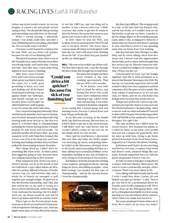Winning the title that year saw him pitted against other champions in a Porsche Motorsport International Cup Scholarship shootout at the Oschesleben.
Bamber emerged victorious with €200,000 towards his budget for the following year’s Porsche Supercup championship. As was becoming his habit, he won that too, becoming the first rookie ever to do so.
During the same season, Bamber also competed in the Asia Cup, which he retained, as well as running second in the German Cup until Porsche pulled him out, deciding they had seen enough. Bamber was impossible to ignore.
“I was racing nearly every single weekend, which made me really strong,” he says. “What was the key thing to being successful was just driving as much as I possibly could.”
Bamber found himself parachuted into Porsche’s Petit Le Mans squad, and after a solid showing there made it to the aforementioned Daytona race.
“If I’d never driven in A1 GP or GP2, I probably would have never got the chance to go into an LMP1 car.”
Prior to his Le Mans selection had come a testing shootout at Porsche’s highest table, the LMP1 squad. It was his years climbing up the greasy single seater pole that had put him to the forefront of Stuttgart minds.
“It was quite ironic because the test came from my early single seater stuff,” he says. “Most of the other Porsche drivers had never driven a similar car. If I’d never driven in A1 GP or GP2, I probably would have never got the chance to go into an LMP1 car.”
Climbing aboard the Porsche 919, Bamber wasn’t quite prepared for what he found.
“The biggest thing with the hybrid power is that it’s normally associated with being clean and green and not so much performance,” he says.
“But the amount of power you have from a hybrid system…There’s no ramp-up time – in a normal combustion engine to get the power, it takes a moment or two. But with a hybrid it’s just instantaneous – it’s shocking to the system how powerful it is.

The winning Porsches cross the line
DPPI
“A 400hp hybrid system can feel like an 800-900hp normal engine.”
For Bamber, the car’s aerodynamics had to be felt to be believed too.
‘At Spa, you’d go through Eau Rouge flat at 300kmh easily,” he says. “It was phenomenal and just so quick – really, really crazy.”
Bamber acquitted himself well and got the nod for Le Mans. Paired with Nicky Tandy and F1 star-turn Nico Hulkenberg, the trio had little time to prepare in a car that was also new to the game.
“Many people don’t know that our car had never finished a 24 hour endurance run of any kind,” he says. “I think everyone knew the cars would be quick, but we weren’t sure whether they would last or not.”
Hulkenberg took the lead after the sixth hour, and Bamber’s faith in the car was sorely tested from thereon in.
“I like to try go find the most difficult things to do. That’s all you can ask for as a driver, to challenge yourself”
“The last bit was horrible, because I can tell you, you hear absolutely every noise and every sound you could imagine inside the car. It was difficult not from a sporting side, but just from a pure nerves side!”
The New Zealander needn’t have worried, as the no19 car eventually won by over a lap.
After years of struggle, facing a life without racing, Bamber did feel like it was a redemption of some kind.
“At the end of the day, it was a cool journey and mountain to climb,” he says. “For me, year in year out, I like to try go find the most difficult things to do. That’s all you can ask for as a driver, to challenge yourself. I think Le Mans 2015 is the best race I’ve ever done.”
Bamber was then given a full crack at the 2017 WEC title, which he won at first time of asking. Another Le Mans win that year made it all the sweeter.





